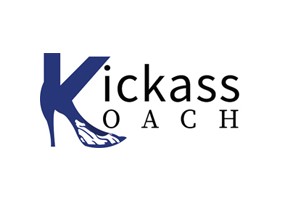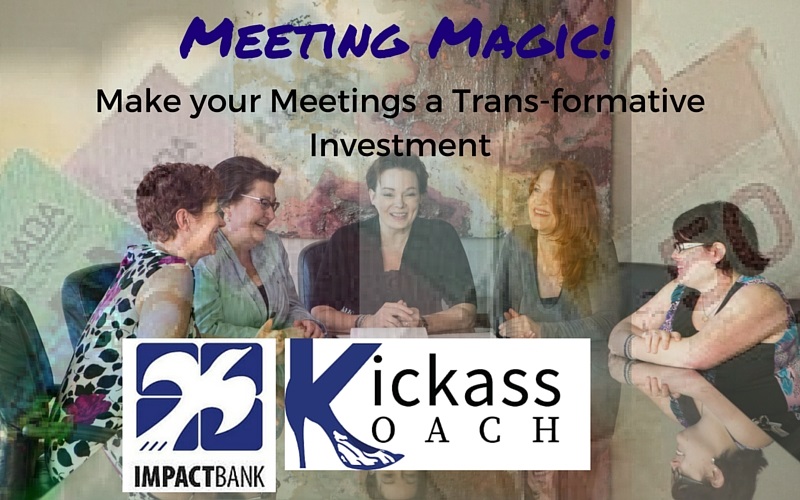Powerful meetings don’t just happen.
Powerful productive meetings start with the mindset of the Senior Leaders in the organization. At ImpactBank, we exclusively work with Senior Leaders during their first two years in a new assignment – we have a signature system we call ON YOUR MARK….™ focusing on those critical first 6 months in a new role. Contact us if you or a senior leader in your organization would benefit from a thinking partner as they navigate the first six months. We are piloting a new approach to delivering this system in September 2016 and we are accepting applicants right now.
WANT TO MAKE MEETINGS MATTER? DO YOU WANT THEM TO BE TRANS-FORMATIVE?
of course you do……you will need to understand and apply…
The Three P’s:
- Preparation
- Process
- Practice
Meetings are a competitive advantage for any organization who masters them.
Imagine how much more productive and how much of a difference you could make if you mastered the art of meetings.
It isn’t as hard as you may believe. Just because very few have done it, doesn’t mean you can’t figure it out. A little secret: it is all about discipline and consistent practice.
In the podcast series that started April 29th, I began to dig into meetings using a little formula and a set of guidelines. I expect you will play with them and I look forward to hearing about your progress. The first 2 readers who share their stories with me at info@impactbank.ca will be invited to participate in my ON YOUR MARK….™ pilot, beginning in September 2016 at half the assessed fee (the fee is reduced if you are a leader in a non-profit, NGO or public post-secondary college or university). Click HERE for more details on the program.
THE PODCAST
Episodes 44-47 discuss the Three P’s (each week I edit this blog adding the new audio file for easy access).
- The first – Episode #44 – introduces the power and influence available to Senior Leaders who embrace the opportunity offered by meetings, focusing on WHY and HOW meetings can transform and improve Performance – not technically one of the “P”‘s!
- The second – Episode #45 – digs into the power and purpose of “Preparation”
- The third – Episode #46 – suggest ideas on how to create a meeting “Process” or “Path” making the conversations come alive with purpose.
- The fourth – Episode #47 – explores the role of “Practice” to achieve “Progress” making your meetings an investment in your most precious resources – TIME & PEOPLE.
If you call a meeting you are responsible for the talent and resource in the room. Don’t waste it. Treat the people and the time with respect.
WHY POWERFUL MEETINGS MATTER.
PART 1 – 044 Live April 29th
Things to Consider
- Reflect on how you
 r meetings are conducted: How is the time used? How prepared are most people when they arrive? How productive are the discussion, decisions and how do they play out between meetings?
r meetings are conducted: How is the time used? How prepared are most people when they arrive? How productive are the discussion, decisions and how do they play out between meetings? - What are some guiding principles you could put into place to make them more productive, more actionable, more focused and more meaningful – write them down and talk with members of your team this week to gather their thoughts and ideas.
- What different roles could you play to give you more insight into the team, more influence over outcomes, AND more innovative solutions and ideas for the future of your agency…try these different roles on for size. I have recommended, what I call the “Quiet Leadership” approach, for a few of my clients lately because I find, no matter how much senior experience a leader has when they accept a new assignment with a new team they feel the need to talk more – BIG SECRET: the leader who talks LESS has more influence. As I say in the podcast – more SHOW, less tell.
BTW – most leaders think this is going to take too much of their time. What you will find in the long run is that your investment in improving the influence of your meetings will free up a lot of time. You may get home for dinner on time every day of the week – sound good!?
Things You Can Do
Set some goals to make your meetings progressively better over the next six months. As we dig into the 3 P’s it will be helpful if you have established a few goals so you can mark your progress as you begin to improve the power of your meetings .
.
In the coming week’s I will have long lists of what you can do to improve your meetings so in addition to the reflections and conversations I have suggested today, work on being more observant of the meetings you do attend whether you are leading them or not. By simply starting to notice what is working and what is not, the rest of the series will be more powerful in supporting your thinking and ideas.
If you are anything like me (and you’ll hear about it in my story in Episode 044) you’ve allowed meetings to be more about sharing information than about inviting open conversations where ideas and perspectives help everyone think more clearly and work more efficiently together.
Only when I had to lead through a significant change/growth period did I realize how disfunctional our meetings had become. I had allowed it. I had to fix it. How about you?
PART 2 – 045 Live May 6th
Things to Consider
- Meeting are a competitive advantage – most organizations have not maximized the power of meetings. You can make a hu
 ge difference if you do. And remember it is not about perfection but progress…you need to start with wanting to get better at meetings.
ge difference if you do. And remember it is not about perfection but progress…you need to start with wanting to get better at meetings. - The mindset in a meeting is critical – if you attend with an empowering, inclusive and collaborative mindset even a mediocre strategy or set of techniques will make a significant impact.
- Remember, if you call a meeting you are responsible for the time and talent in the room so treat them with respect.
- Inspire ownership in the meeting by all participants – it will really change the dynamic in the room…people will see different things, have different reactions and they will participate differently.
Things You Can Do
- Look offer a meeting agenda you have coming up and consider asking yourself these questions (join my mailing list using the link in the podcast summary page – or on the home page of my website – and I will send you a single page outline for this exercise):
- Now rebuild the agenda based on your answers and:
- Consider the purpose for each agenda item/topic and either include it on the agenda you send out in advance OR be prepared to share it as the topic is opened for conversation
- Develop a path for the conversation – it may be a simple one, to begin with, but know how you plan to facilitate the conversation AND it may be a different path for each topic…there will be more on this next week when discussing and mapping the process
- Establish a framework for each agenda item:
- What background might people need before the conversation is opened up? Is it appropriate to send something in advance so people can acquaint themselves more fully with the subject matter and, where appropriate, the related data?
- You may even consider giving them points for thought and reflection BEFORE the meeting. Over time they may start consulting their own team in advance of the meeting. Think about how productive your meetings will be when they engage their teams in advance of the meeting and come prepared for robust conversation!
- Consider what you specifically want as a result of the conversation so you can explicitly ask for it. Ideas? Different perspectives from different functional groups or leaders? Actionable Plans and Commitments?
- A welcome side-effect: members of your direct reporting team will start to design their meetings to feel like yours and your influence will expand and productivity will soar!
While one conversation/meeting may not change the complete trajectory of your organization or improve the outcome of any project or improvement you are working on, EACH ONE has the POTENTIAL to do exactly that – IT CAN BE MAGICAL!
PART 3 – 046 Live May 13
Things to Consider
- Regardless of what you have come to believe about members of your team, people want to feel aligned. Aligned to and with what, you ask? Reflect on that. People do their best work when they are aligned. People contribute more fully and creatively when they feel like they are part of something and NOT simply completing a task. When your meetings become transformative they will generate meaningful conversations. Unlike the transactional meetings where it is just about information updates or transfer of knowledge and information – let’s face it we use meetings to down load information rather than to host conversations AND that is part of what makes them so painful. To develop alignment ESPECIALLY if you are leading meetings with people who are given a directive or a mandate rather than co-creating one requires meaningful heartfelt conversation. Most, not all, senior leaders are uncomfortable about this AND YOU NEED TO FACE THAT AND GET COMFORTABLE BEING UNCOMFORTABLE. Maybe you start by taking time in your next meeting to host a conversation about alignment –
 most people will tell you what they need to feel aligned YOU JUST HAVE TO ASK and you need to make it safe for them to answer.
most people will tell you what they need to feel aligned YOU JUST HAVE TO ASK and you need to make it safe for them to answer. - If the meeting has more than 10-15 participants put the meeting path up on a big board so everyone knows the topics and the purpose of each. You may even consider posting the details of the path you intend to follow to dig into each topic – this will often ensure each member self manages. Leaders have found this approach can save about 15-20% of the time – that may result in every meeting ending on time – wow that would remove a lot of the pain associated with meetings. In smaller groups (5-15) it can still be helpful to post the path but, in time, especially with intact teams the structure will be less onerous to manage so you may be able to stop posting once the meetings have shifted appropriately.
- If you have established meeting protocols post those too and if you don’t you, may want to take a few minutes at the beginning of your next meeting to ask for a few suggestions – this will help you stay on track in the meeting which is key to a powerful meeting. BONUS: these meeting protocols can be a tool for encouraging dissenting and diverse perspectives while building alignment.
- Whether you come prepared to use them or include them within the agenda, your meeting may benefit from carefully crafted specific questions to guide the conversation on each topic. Lay them out all at once and then go back and invite comment and then facilitate the conversation that develops.
BIG SECRET: A well crafted question opens people up for creative conversation while an opening statement may reduce the creative engagement around the table (or over a conference bridge).
Things You Can Do
Once you have your agenda as we discussed last week, build your path around that – regardless of the details you will want to have three distinct components which I will outline below – this is something for you to practice using in the coming week.
- Opening or staging – This is where you set the tone and if you have more than one topic for the meeting you may want to establish an opening for the entire meeting where you review the path and the guidelines the team established. You may want a short opening for each topic – include related research, past experience with the topic, outline ultimate goals, identify people in the room who may bring expertise in one aspect of the topic and be sure to invite them to bring this to the conversation as they wish. Treat this much like you would an Executive Summary if you were writing a report.
- Meat or Inquiry or Content – Now that you have set up or staged a topic for conversation, you invite either a focused discussion or a free-for-all depending on the topic, size of t
 he group or your experience with the group. You may have specific questions planned or exercises to generate thinking, even debate and expanded brain storming – if you are not a skilled facilitator ask someone on your team who is if they will co-host specific sections of your meetings AND when you have a critical meeting or topic you may consider engaging someone from another department who specializes in facilitation or bring some one in from outside the organization to facilitate. You are already investing in the resources in the room – don’t let Loss Aversion Bias keep you from investing in whatever will make the meeting most productive. The ability to foster engagement of all participants will determine the power of your conversations. If you haven’t mastered this skill YET, get help.
he group or your experience with the group. You may have specific questions planned or exercises to generate thinking, even debate and expanded brain storming – if you are not a skilled facilitator ask someone on your team who is if they will co-host specific sections of your meetings AND when you have a critical meeting or topic you may consider engaging someone from another department who specializes in facilitation or bring some one in from outside the organization to facilitate. You are already investing in the resources in the room – don’t let Loss Aversion Bias keep you from investing in whatever will make the meeting most productive. The ability to foster engagement of all participants will determine the power of your conversations. If you haven’t mastered this skill YET, get help. - DO NOT SHUT PEOPLE DOWN DURING THIS STAGE…here are examples of questions you can tailor for yourself:
- What is it about this topic that is important to you or the department?
- If we were to scale where we are against where we want to be at the end of this process – 10 being totally resolved and 1 being flat on our faces – where would you say we are and what is a reasonable place ON THE SCALE to be by the end of the process? What do you see we need to do to move the needle from X to Y? (Maybe ask each individual to do this privately before inviting individuals to engage).
- What challenges do you foresee if we move forward with what we are discussing that hasn’t been offered yet?
- What would you individually and as a team need from me today to give you the best chance of making this happen?
- Closure – THIS IS CRITICAL AND FAR TOO OFTEN AVOIDED BY THOSE WHO HAVE NEVER EXPERIENCED THE POWER OF MEETINGS. Leaders tend to want to move to the next meeting or wrap up a topic which is another reason you may not want to be the facilitator. When possible it may serve you well to be an observer in the most important meetings. I promised a few suggestions for closure:
- Briefly recap what was discussed – incorporating all key perspectives, all decisions and of course deliverables that were assigned to members of the team. Ask whether you missed anything AND request agreement to move to the next topic or close the meeting. You may consider asking different members of the team to close each topic – if this becomes part of all meetings everyone will be listening differently so they are ready to recap when called upon to do so.
- Depending on the topic or type of meeting you may wrap up but articulating the value points you are leaving the meeting with OR you may ask each member of the team to do so.
- You may wrap some topics or meetings by using a visual diagram to consolidate commitments and ensure understanding on what will happen between meetings related to each topic. With this type of closing, you will benefit from a visual aid – maybe even posted on a screen for all to see.
- You may even wrap up a topic by agreeing on who will do more research, what loose threads require further discussion at the next meeting and ensure everyone agrees to reflect further and come prepared for the next conversation on that topic.
Studies on productive teams and meetings have demonstrated that 63% of all plans are NEVER completed and I suggest weak closure in meetings may be one of the biggest reasons.
THE OTHER IMPACT? Failing to ensure effective closure in meetings be the #1 reason you find yourself back in the same conversations over and over again.
GOOD NEWS – you can make a huge difference by learning to leverage meetings by investing time in strong meeting process and especially the art of closure.
Improve the power of your meetings.
PART 4 – 047 Live May 13
Things to Consider
- Do you track and measure your progress between meetings and what if you did? We know that what we measure is more likely to get done and more importantly, improve. In my first six months as CEO at Regency I noticed what appeared to be really high consumable spending that had been consistently increasing for no apparent reason – my financial dashboard tracked it at a percent of revenue so I suspected this upward trijectory was not simply about supporting the growth. I got curious about it and as a result of my curiousity I would ask more questions about resources and spending. I wasn’t prepared to get too detailed about it but I was intrigued how my questions alone seemed to turn the trend. Regency’s fiscal year end came 10 months after I started and as I reviewed the financials it was interesting to see the impact I had by simply asking questions. Because we were a highly regulated industry we had annual audits and this interesting trend was questioned by the auditors which gave me a chance to posit my suspicion that “by first measuring and then asking about the results could shift behaviour and results.” I knew the importance of measuring but this was a fascinating example of how the impact.
- Do you keep meaningful notes on your meetings? Did you know that most conversations even those that are rema
 rkable have a short shelf life before they are clearly and accurately remembered – that is usually 40 minutes so if you don’t have a strong mechanism for keeping meaningful notes you are often wasting a lot of your time in meetings. Identify someone who will appreciate being asked to memorialize the conversations and support them in developing this powerful contribution.
rkable have a short shelf life before they are clearly and accurately remembered – that is usually 40 minutes so if you don’t have a strong mechanism for keeping meaningful notes you are often wasting a lot of your time in meetings. Identify someone who will appreciate being asked to memorialize the conversations and support them in developing this powerful contribution. - As the Senior Leader how do you set the tone for actions committed to in meetings? What expectations have you set for people to own their commitments and report if they are hitting obstacles to achieving them? I suggest when you have a system and it may require some thought and practice to develop, you will influence the degree to which people keep those commitments. Remember they want to keep those – and when you support them in doing so your team will become one of excellence.
- How do you ensure people can quickly START acting on commitments after a meeting? Do they often have back to back meetings AND DO you? What if the way you have designed work days is the reason you are spinning your wheels or frustrated with the performance of your people? Worth your time to reflect on this? Meetings are critical to collaboration AND yet poorly designed work days will make meetings a burden and even a waste of time.
BIG SECRET: When you as a Senior Leaders remember your direct reports want to be exceptional and want to deliver on their commitments, you will remove the barriers that restrict their workplace structure and flow. Remember the reason you want to fly at 30K feet periodically is so you can see opportunity to leverage the path ahead and maximize your resources.
Things You Can Do
Once you have your agenda as we discussed last week, build your path around that – regardless of the details you will want to have three distinct components which I will outline below – this is something for you to practice using in the coming week.
- Identify someone on the team who is a concise thinker, succinct communicator and who would feel valued if asked to document the meeting. Devote some time initially to discuss a structure or design for those notes. Good meeting notes keep everyone on track. GREAT meetings notes bring ideas, thoughts and plans together and help the entire team build on every conversation. When you value this key role a huge gap in your meetings will be filled. Once you have mentored and supported this member of the team leave them the creative freedom and you may be surprised by how powerful the notes will become
 .
. - Meeting notes and progress tracking are similar but not the same. Identify another member or a few members, depending on the complexity of your needs, to track progress on actions taken against specific decisions made in meetings. If there is someone on the team who enjoys project management they may appreciate the opportunity to design something. Invite them to share it with the group – using the meeting elements we’ve talked about for powerful conversations and then test it as a mechanism for tracking and measuring the group’s commitments. I have found a simple dashboard approach with just a handful of metrics to measure progress to be most helpful especially when members of the team hold responsibility for different deliverables that all, in some way, impact the elements measured on the dashboard.
- You may benefit from taking some time this week to reflect on how you set expectations. Do you apply persistent follow up to support your team in accomplishing the commitments they have made?
- A simple note or a drop-by to see them may be enough. Keep it simple by asking two questions. Those questions may be something like: How is “X” going and do you need anything from me to help you reach your goal? What obstacles are you encountering and how can I help?
- What standard have you set for reporting between meetings? One of my clients successfully established a simple expectation: he would remind his team at the end of every meeting that he understood…”life happens and there will be times you can’t keep a commitment so all I ask is that if something gets in the way of you keeping a commitment to achieve what we talked about in this meeting by the time we set, I need a phone call – this will give me a chance to adjust related elements and/or help… if I don’t hear from you I will trust it will be done”.
- Help your Direct Reports examine their schedules – is their schedule getting in the way of them completing their work or accomplishing their goals with quality and efficiency? When you are curious about these things at a high level it invites members of your team to think differently about their value and contribution. This takes me back to the importance of Senior Leaders to get up into the air and fly at 30K feet – that perspective gives you insights that will help you support your Direct Reports.
Your currency as a leader is presence, purpose and passion so make a deposit every day. #BankingYourImpact
ImpactBank’s the Kickass Koach Podcast
ImpactBank’s – the Kickass Koach is on i-Tunes AND you can always find the most recent episodes on ImpactBank’s main website page with a link to iTunes to make it easier for you to subscribe. Of course the podcast link on the website navigation bar also takes you to all episodes.
ImpactBank’s The Kickass Koach podcast supports senior leaders who want to quickly master the art and practice of leadership while stepping into a new assignment. When you were promoted into a senior position, if you’re like most people, you were immediately excited b y the opportunity to really make a difference. You also soon realized the immense, even daunting, challenge ahead of you.
y the opportunity to really make a difference. You also soon realized the immense, even daunting, challenge ahead of you.
You quickly had feelings of being lost, overwhelmed and very alone. It is completely understandable – you need to find your leadership rhythm. We help you find your leadership presence – one that will both command a room and warm hearts so people want to follow you and exceed your expectations – then you will know what it feels like to really make an impact.
From the Kickass Koach Archives – This Week’s Recommendations:
Episode 41: Feel Stuck? You want to test your wings as a senior leader – try new things – make your mark! Well it’s really difficult when you are weighed down by an anchoring bias.
Episode 23: Don’t leave ’em hang’n! When people are left to make sense of the direction given by a leader, you will find you all end up somewhere you had no intention of going. So why then do we continue to leave people feeling unsettled and unclear on what is expected of them, how they are doing and how to be better?
Last Week’s Recommendations:
Episode 40: Feel Stuck? You want to test your wings as a senior leader – try new things – make your mark! Well it’s really difficult when you are weighed down by an anchoring bias.
Episode 22: Don’t leave ’em hang’n! When people are left to make sense of the direction given by a leader, you will find you all end up somewhere you had no intention of going. So why then do we continue to leave people feeling unsettled and unclear on what is expected of them, how they are doing and how to be better?
Recent Recommendations:
Episode 39: Biases are unconscious internal influences that determine how we see and experience the world – this is a look at Confirmation Bias.
Episode: 21: As a leader, when you welcome and value everyone’s contribution you have a better chance of getting the best outcomes. This episode explores the threat response that is triggered when you FAIL to value people.
Episode 38: the beginning of the series on Bias.
Episode: 20: What activates threat responses and how do we respond to minimize the negative impact and maximize the positive?
ImpactBank’s Diversity System: The Diversity Dividend
Would you or your organization benefit?
We tailor the program to the organization’s and leader’s specific needs and current challenges.
Are there conflicts that persist between stakeholder groups or within specific work groups?
Do you routinely experience poor compliance rates? (In other words, are there requirements that workers just fail to meet on a regular basis? Do you have poor attendance or high attrition rates? Are there constantly mistakes made in working with stakeholders? Are acceptable levels of service only met by some members of the team or not consistently across the team?)
Do you find yourself frustrated because you have to say the same things over and over and you can’t get people to take critical requirements seriously?
Are there conflicts bubbling beneath the surface? Are you and your team tripping over biases and failing to achieve the required outcomes?


Hello! Cool post, amazing!!!
Thanks Bobbu